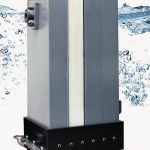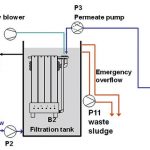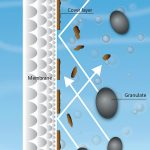Membrane bioreactors have a compact design and deliver a high effluent quality. However, the membranes have to be cleaned regularly. The cleaning chemicals entail additional costs and if hypochlorite is used, harmful by-products may result. The Bio-Cel module in combination with a newly developed mechanical cleaning process based on granulate allows the MBR to be operated without chemicals. In addition, a significant increase in performance is achieved.
The authors: Wolfgang Schöne Sales Manager, Microdyn-Nadir Majk Milovi´c MBR Application, Microdyn-Nadir
Conventional waste water treatment plants, in which organic water pollutants are elimi- nated in an activated sludge process, can be improved by separating the biomass by means of membranes. The membrane modules are submerged directly into the aeration tank or a separate filtration tank. Clean water (permeate) is drawn through the membranes by applying a vacuum on the permeate side. Using membranes has two essential advantages: the whole plant has a smaller footprint and the effluent quality is increased. The footprint is reduced by about 50 % because the process can take place at a higher biomass concentration (about 10 to 12 g/l compared to 3 to 5 g/l in a conventional treatment plant) and the sedimentation tank can be omitted. The superior effluent quality is attributable to the ultra filtration membranes, which function as an absolute barrier against particles including bacteria and viruses. Waste water that is cleaned in this way can be reused directly. By adding a further treatment step, i. e. nano filtration or reverse osmosis, high-quality process water can be obtained.
Operating principle
The high biomass concentration results in a significant fouling potential for the membranes. Additionally, the sludge from industrial waste water treatment plants is more difficult to filter compared to municipal waste water treatment plants. However, industrial waste water treatment plants frequently use MBR technology to close water cycles. The build-up of fouling layers can be minimised by design-ing the modules without any dead zones or points of attachment for sludge accumulation in combination with crossflow aeration and periodical backwashing, but it cannot be avoided completely. Thus, periodical membrane cleaning is necessary. Organic cover layers can be removed using oxidising cleaning agents like sodium hypochlorite (NaOCl). Unfortunately, cleaning with agents containing chlo-rine entails a risk that ecotoxic by-products will be produced (well-known under the sum parameter AOX). To overcome this disadvantage, a mechanical cleaning strategy based on the use of plastic granules was developed for the Bio-Cel module. Triggered by the crossflow aeration, the granulate circulates between the membrane sheets and the module surroundings. The moving particles hamper the build-up of fouling layers and continuously remove deposited sol-ids from the membrane surface. The particular advantage of the MCP (Mechanical Cleaning Process) method is that the process is carried out without interrupting filtration. Pilot tests with industrial waste water provide impressive confirmation of MCP’s success.
Pilot tests on an MBR plant
The waste water treatment plant of a production facility for synthetic, organic fibres needed to be enlarged to cope with the increased amounts of waste water caused by extended production capacity. There was no space available for expanding the biological treatment facility, so it was decided to upgrade to an MBR plant by installing submerged membrane modules. The high concentration of fibres in the water which results from the production process makes high demands on the hydraulic conditions in the module, because the fibres may cause braiding. Since the Bio-Cel module, with its self-supporting, backwashable membrane sheets, offers no points for fibre attachment, braiding is ruled out.
The benefits of MCP for the MBR reactor were verified with the help of pilot tests. The main goals were to reduce the footprint to a minimum and simultaneously ensure the maximum possible cleaning capacity in the plant. For this purpose, two test phases were conducted in a 10’ container plant, which was equipped with two Bio-Cel BC10–10 modules. During the first of the three-month test phases filtration was carried out without MCP, while during the second phase the plant was operated with MCP.
The test plant comprised a fine screen (1.0 mm sieve), a filtration tank and a permeate tank. Waste water was pumped into the filtration tank by an external pump and returned to the aeration tank by means of an overflow. The two modules, with a total filtration area of 20 m², were submerged in the filtration tank. Permeate was sucked out of the tank by means of a slight vacuum (between -50 and -200 mbar). During phase 1, the sludge concentration was 12 g DS/l, which is common in MBR plants. The membrane flux amounted to 12 to 15 l/(m²h) at a transmembrane pressure difference (TMP) of -150 mbar. The peak flux of 19 l/(m² h] was achieved with a TMP of -200 mbar. The fluxes are less than those in municipal MBR plants because the aerated sludge of an industrial waste water plant is harder to filter.
Operation with MCP was investigated during phase 2. In this case, the TMP decreased to -100 mbar at a flux of 15 l/(m² h) and did not even rise at the peak flux of 19 l/(m² h). Continuous cleaning of the membranes with granules works effectively, in other words, and contributes to an increase in the average membrane flux.
In addition to the smaller footprint due to the omission of the sedimentation tank, extra space can be gained by filtering with MCP because the size of the filtration tank can be reduced from 25 to 15 m³. Furthermore, the energy consumption of pumps and blowers is less.
The pilot tests revealed that MBR technology is fully developed and able to deliver good fluxes even under difficult conditions (depending on the waste water situation). The success of MBR operation with Bio-Cel-MCP and its advantages compared to normal operation (without MCP) showed that higher fluxes are also pos-sible with industrial waste water.
cpp-net.com/0112452
Share:











